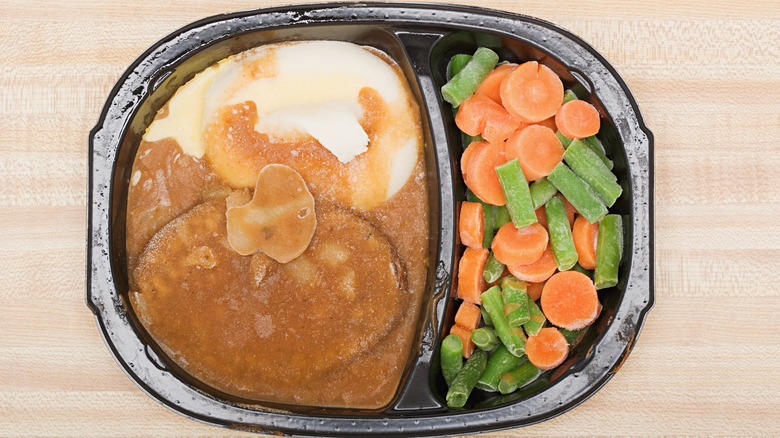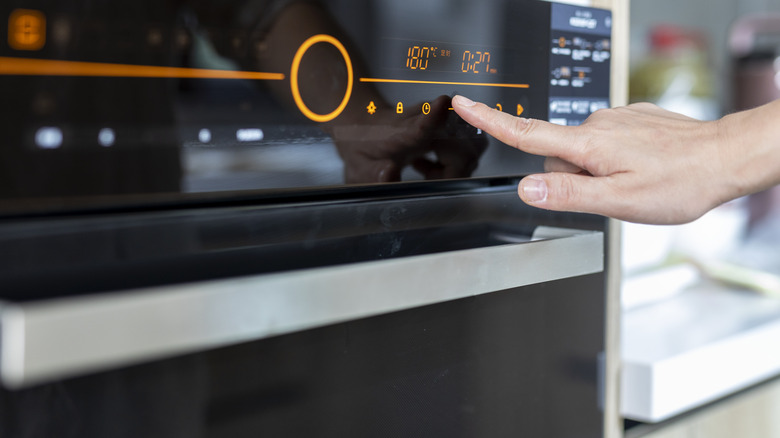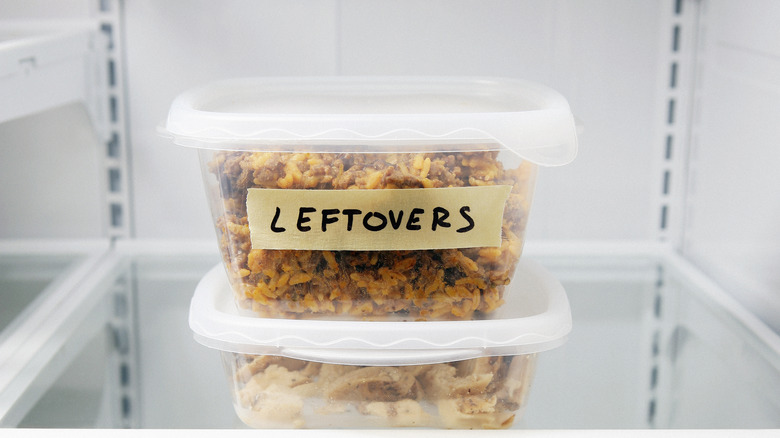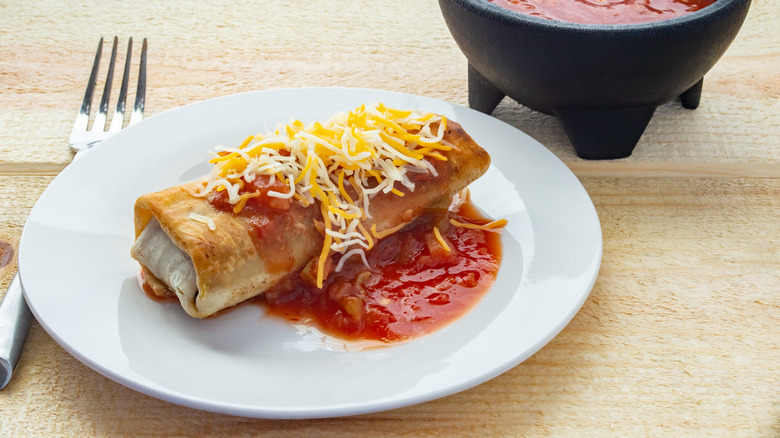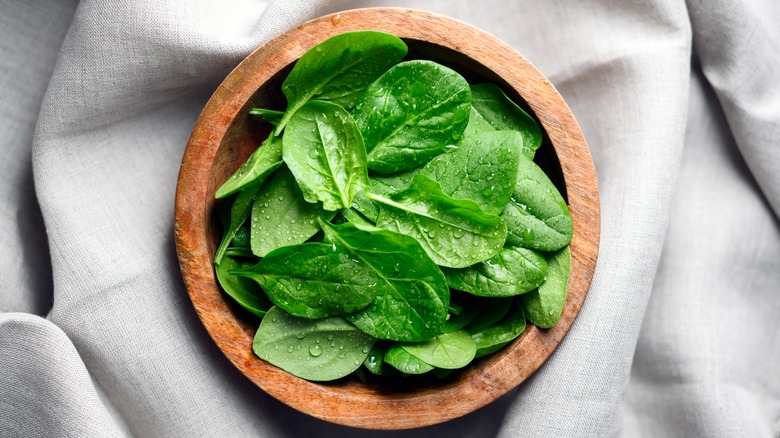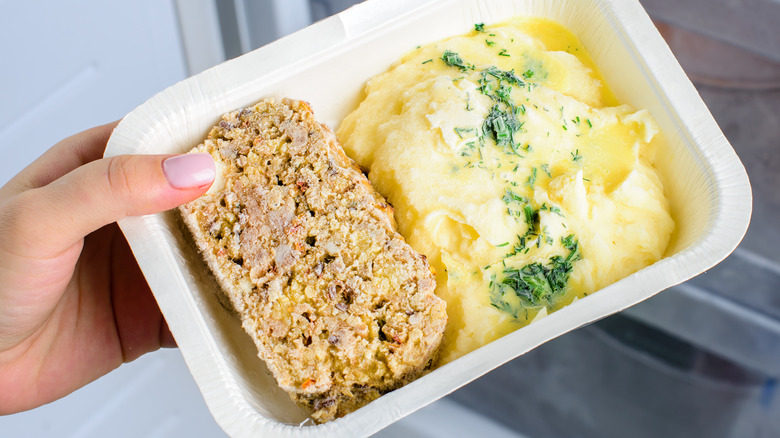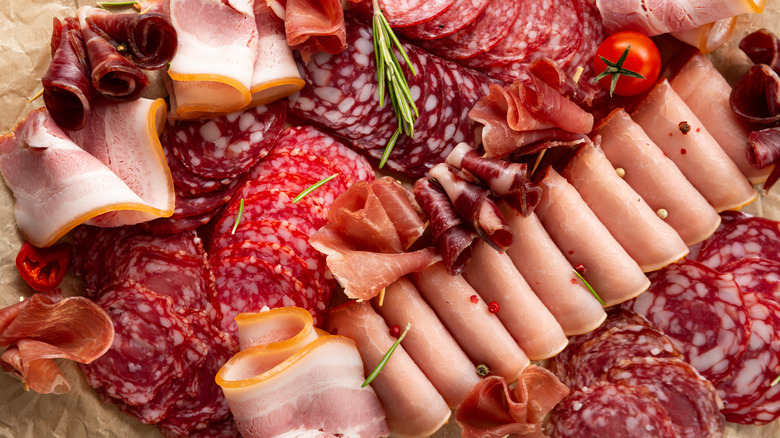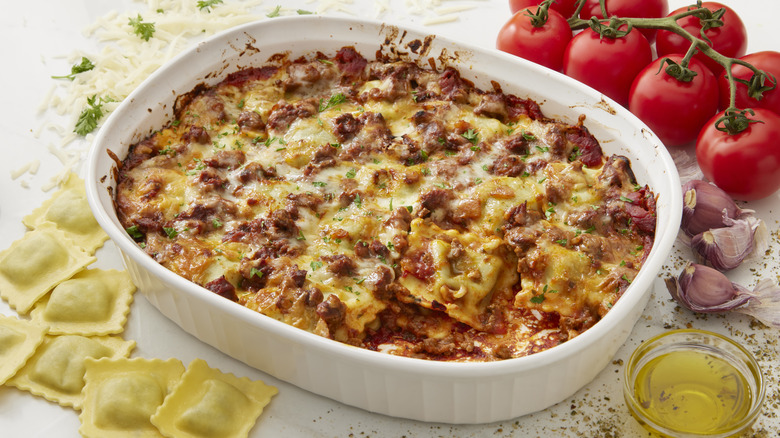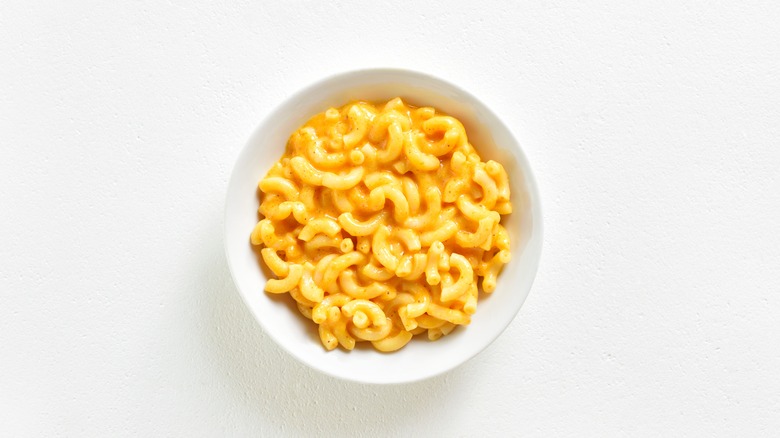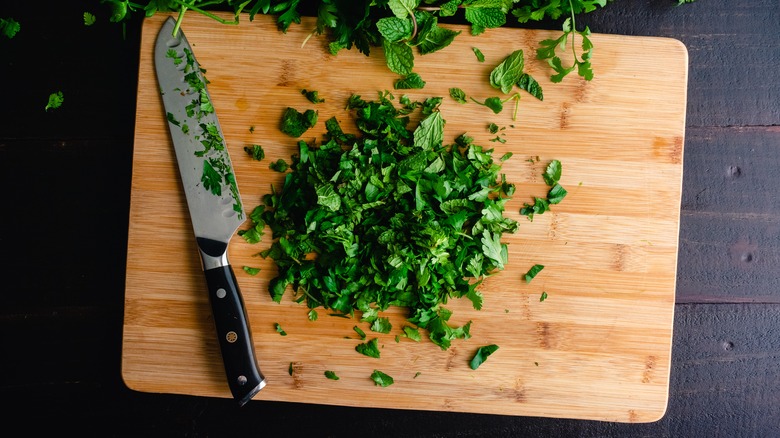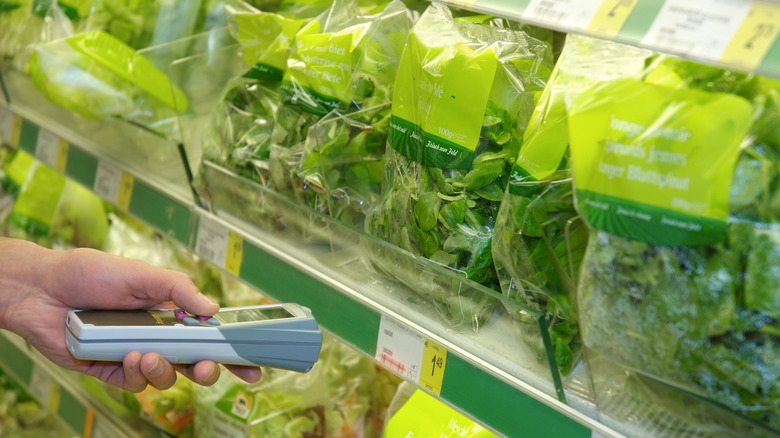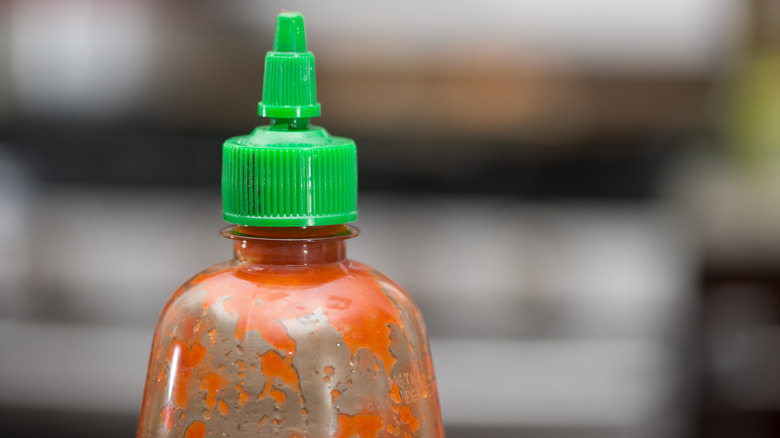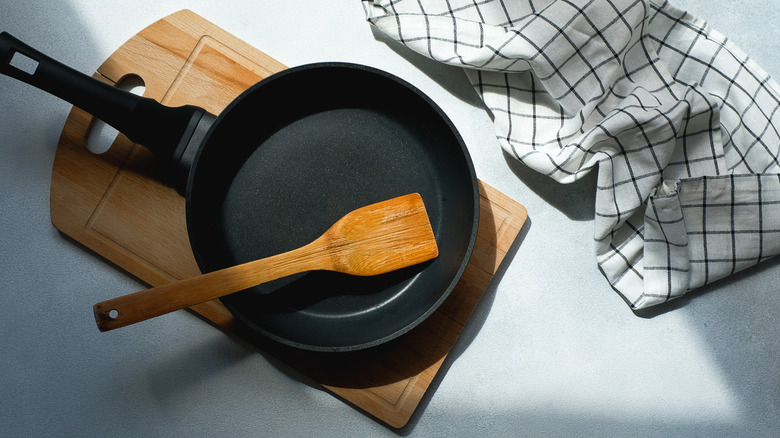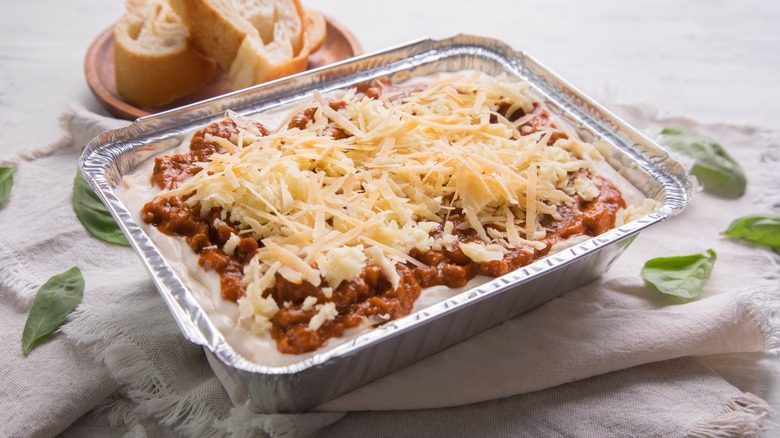13 Expert Tips For Making Frozen Dinners Taste Better
In millions of households across the country, frozen dinners are a regular part of your weekly meals. There's no denying how far these convenient dishes have come. While there may have been a time when frozen dinners were often laden with unappealing additives and copious amounts of salt, nowadays there are dozens of frozen dinner brands that are made with the highest quality ingredients and that source their flavor from carefully chosen components. Unfortunately, though, not all frozen dinners are as good as they could be -– and for the ones out there that are still a little flavorless, you might need to make some alterations.
Luckily, boosting your frozen dinners is easier than you probably think. There are loads of ways to make your frozen dinners taste better, with standby ingredients like herbs, spices, and bottled sauces all capable of adding enormous flavor. You can also tweak the way you cook your frozen dinners to fill them with new tastes and textures, turning them from gormless to gourmet. There are so many methods for making frozen dinners taste better that we didn't quite know where to start. So we reached out to Jessica Formicola, chef, cookbook author, and food judge on the Emmy-nominated show "Plate It! Baltimore." Formicola, who's the owner of Savory Experiments, told us everything there is to know about making frozen dinners more delicious.
1. Opt for your oven when possible
The beauty of frozen dinners is that they deliver food that would normally take hours to make in just a few minutes. You can just pop them in your microwave until they're piping hot, and you're good to go. While this method is definitely quick, it's not the best way to add flavor — and if you want to give some of the most popular frozen dinners a boost, stick them in the oven.
Jessica Formicola points out that while not all frozen dinners are best-suited for the oven, with single-serve options likely being easier to cook in the microwave, some really benefit from it. "Something like a tray of lasagna needs to be done in the oven for optimal results," Formicola says, with other pasta dishes also faring well in the oven. Just be sure the container is oven-safe, or transfer your food into one that can withstand the heat.
The advantage of cooking frozen dinners in the oven is that you give them access to dry heat, which unlike the microwave helps to brown and caramelize your food. This browning deepens its flavor and unlocks extra dimensions in your food. There's no denying, however, that oven cooking takes longer than microwaving, and it could be a slightly extravagant way of cooking your meals if you're only cooking for yourself. If you're catering for a crowd, though? Fire it up.
2. Throw your leftovers into frozen dinners for more flavor
If you're anything like us, you usually end up with a fair number of leftovers in your fridge by the end of the week. It can be difficult to know what to do with these small, yet delicious morsels of food, especially if you have only a spoonful or two left. Don't be tempted to throw them away, though — there are a lot of tricks to using up your leftovers, and one of our favorites is to throw them into your frozen dinners to give them an instant boost of flavor and make them more substantial.
"I take a tray of Stouffer's mac and cheese and elevate it using BBQ pulled pork or leftover ground beef from tacos," says Jessica Formicola. She then likes to spruce the dish up further by adding in extras like frozen peas or sun-dried tomatoes as well as some stronger cheeses to give the frozen mac more depth. By doing this, Formicola creates a casserole out of what would normally be a side dish. Frozen fried rice dishes are also very receptive to leftovers. Try adding in some rotisserie chicken or flaking some leftover fish in, stirring through until everything's hot. If you have any leftover hard-boiled eggs, these can also be thrown in to give your rice a boost of protein.
3. Top your frozen burritos with jarred sauce
What do you do with frozen burritos? If you're just eating them straight out of the pack, you're missing out. These flavor bombs can be made even more flavorful by topping them with jarred sauce, turning them into an enchilada of sorts. Depending on the sauce you choose, doing this can add spicy, tart, or creamy notes to your frozen burrito, and introduce some much-needed moisture to what is sometimes a pretty bland dish.
We like to pick our sauces to contrast the flavors already present in our burritos, to create a profile that's more well-rounded. For example, if your burrito doesn't have any cheese in it, pour over some jarred queso. If your burrito is on the milder side, pick up an enchilada sauce to add in some all-important spice. If your burrito is full of dense, savory ingredients like beans and meat, try dolloping on some jarred pico de gallo (okay, we know it's more of a sauce than a dip, but you'll thank us for it), which will provide a burst of zingy freshness. Don't feel as though you have to cover your burrito here, either: Even a spoonful or two will make a big difference.
4. Mix in extra vegetables for nutrition and earthiness
There's no getting around it: The vegetables that come in frozen dinners are usually pretty sad. By the time they reach your plate, they've usually cooked down into mush and have lost most of their original flavor. Luckily, adding fresh veggies to your frozen dinners is easy and gives your meal a boost of flavor while also amping up its nutritional content. It's also a great way to use up slightly wilted vegetables that are about to go past their prime.
You can use fresh or frozen vegetables here, and preserved veggies work just as well, too. Jessica Formicola likes to use all three. "My favorites are chopped spinach or kale (also a good way to add color and veggies), sun-dried tomatoes or roasted tomatoes, roast garlic cloves, frozen peas, frozen carrots and, of course, onions and garlic," she says. Throwing in onions, garlic, and tomatoes will boost your frozen dinner's savory and aromatic qualities, while chopped spinach or kale will give it earthiness and a gently bitter note. Adding your vegetables is usually as simple as tucking them into your frozen dinner about halfway through its cooking time, and nuking them with the meal for a few more minutes so that they soften or defrost.
5. Elevate your frozen mashed potatoes with cheese
Few frozen sides are as reliable as frozen mashed potatoes — but there's no getting around how bland they can be. Frozen mashed potatoes generally don't hold a candle to the fresh kind, and they can often be fairly loose and runny. There's one ingredient, though, that can simultaneously make them taste better and firm them up: cheese. "Stirring in flavorful cheese is an easy way to take mashed potatoes up a notch," Jessica Formicola says. Cheese gives the mashed potatoes a creamy, sharp, savory flavor, and firm cheeses will add structure to the potatoes as they melt and then cool slightly.
You can use pretty much any kind of cheese you have on hand, but Formicola points out that some types will need a little extra attention. "Hard cheeses like a smoked gouda or aged cheddar need to be shredded well to blend in," she says, while you'll be able to stir in soft cheeses without much effort. If you don't have any cheese on hand, the good news is that frozen mashed potatoes are receptive to almost any type of dairy. "Consider adding a good quality butter, sour cream, or plain Greek yogurt for tang," Formicola advises. You can't go wrong with caramelized onions or mashed roasted garlic in your mashed potatoes, either.
6. Add cured meats to your frozen pizza
We absolutely love frozen pizza, but we can't lie to you. Sometimes, it can be pretty boring. The frozen type doesn't come close to the kind you'd get from a pizzeria, and it's usually adorned with minuscule toppings that barely provide flavor. While we know that we shouldn't expect restaurant quality from frozen pizza, there's one way that you can easily amp up its essence: By topping your frozen pie with tasty cured meats.
Naturally, this tip will appeal only to meat-eaters, but the good news is that cured meats go with almost any style of frozen pizza. They're as good on a standard cheese pizza, where they provide immediate salty, savory flavor, as they are on top of a veggie pie, delivering flavor contrast and depth. Adding them to a pepperoni can also introduce extra nuance and richness. Salami, prosciutto, bresaola, and coppa are all great choices for virtually any pizza. Just pop a few slices on top just before you're ready to serve, allowing the heat from the pizza to gently warm them through. If you're looking for a plant-based alternative to this tip, try adding some homemade sun-dried tomatoes or artichoke hearts to your pizza instead.
7. Bring extra flavor to your ravioli by turning it into lasagna
Frozen ravioli is one of those dinners that's always reliable — and frequently boring. If you're sick of boiling your ravioli and topping it with sauce (and don't get us wrong, that's a delicious way of making it), then we highly recommend baking it instead. You can transform your frozen ravioli into a quick lasagna bake by simply swapping out your lasagna noodles for ravioli pieces. All you have to do is assemble your standard lasagna ingredients and layer them up, laying your ravioli flat in place of your lasagna sheets, and then bake.
One of our favorite things about this tip is not only does it give your frozen ravioli tons more flavor, but it also turns it into a full-blown dish. Each ravioli piece gets coated with cheese, meat sauce, and tomato-y goodness, with the top layer crisping gently. You don't even have to thaw your frozen ravioli, either: It'll melt as the lasagna cooks in the oven. Plus, using ravioli instead of lasagna sheets makes serving this take on a lasagna way easier, as you don't have to worry about cutting through the pasta and having everything fall apart. Just ladle it onto a plate, working your spoon between the ravioli pieces.
8. Amp up frozen mac and cheese with bacon and spices
Frozen mac and cheese is, in our opinion, a blank canvas. While it's undeniably tasty on its own, there's something about its gentle creamy notes that invites modification — and it's incredibly versatile, too. One of the best ways to amp it up, according to Jessica Formicola, is with bacon. Crispy chopped bacon or pancetta both work excellently in frozen mac and cheese, where they provide a burst of salty, meaty flavors, and some delightful textural variation.
Frozen mac and cheese also pairs effortlessly with other cooked meats, like shredded chicken or cooked ground beef. To add a little extra nuance, Formicola also likes to include spice. "This Maryland girl loves to add a topping of Old Bay seasoning and sometimes a Steak Rub or Cajun seasoning for spice," she says. The Old Bay delivers hints of paprika, celery seed, mustard, and black pepper, and Cajun seasoning imbues it with pops of cayenne pepper and garlic. If you want something a bit fresher to work against the cheesiness of the dish, Formicola states that chopped scallions or chives can make an awesome topping.
9. Boost flavor by adding herbs
Not nearly enough people use herbs with their frozen dinners — and we're here to change that. Fresh and dried herbs alike are one of the quickest ways to add depth to frozen meals. Fridge staples like parsley and cilantro go with a wide variety of frozen dishes, where they add bright, zesty, gently peppery notes to the food that makes them taste like they've been made at home. Jessica Formicola also notes that sage and basil can also boost the flavor profiles of your dish, with sage adding an earthy, almost lemony taste (which works especially well with chicken), and basil bringing a fruity, gently licorice note.
Dried herbs can have a similar effect, and while they won't give exactly the same zing that fresh herbs do, they still thread your food through with brightness and a vegetal note. If you're adding dried herbs, it's useful to adjust your cooking accordingly. Try to sprinkle them in about halfway through your cooking time, stirring them through the dinner if possible. You'll want them to soften and release all of their flavor throughout the dish, and they'll need to cook slightly to do so.
10. Combine frozen dinners with bagged salad
One of the biggest complaints about frozen dinners is that they just don't feel that healthy. Now, that's obviously not the case for all frozen meals on a pure nutritional level, but it's more a state of mind: If something's been frozen solid and then cooked in a microwave, it just doesn't have that fresh, wholesome feeling that other meals do. One of the easiest ways to combat this is by pairing them with bagged salad. By serving them with an assortment of fresh veggies like lettuce, arugula, kale, carrots, or cabbage, you get all of the bright, zingy flavors that your dinner is probably lacking.
When we're talking about combining your meal with bagged salad, we don't simply mean serving it as a side. Instead, we like to use bagged salad as a bed that we serve our frozen dinner on. This will only work with certain types of frozen dinners, but with power bowls and summer pasta dishes, a bed of bagged salad gives a crunch and gentle pepperiness that complements them beautifully. Quinoa and rice-based frozen dinners also fare especially well in this combo, and even frozen chilis pair excellently with a bed of chopped white cabbage or arugula.
11. Throw in some sauces for easy flavor
We love adding sauces to our frozen dinners, y'all. Pouring in some sauce is one of the easiest ways to add immediate flavor to your dish, and for slightly drier frozen dinners it can also give them a boost of moisture. "Hot sauce, sriracha, curry sauces, and mustard are easy ways to build taste," Jessica Formicola says. Hot sauce and sriracha are particularly useful if your so-called spicy frozen dinner is barely registering on the heat scale, and they can also give your meal garlicky, smoky, and slightly sour notes that create extra dimensions.
You don't have to just go for tart, spicy sauces to boost your dish, either. Try pouring in some ranch dressing to a frozen chicken Alfredo or mac and cheese. The sauce's flavor profile will meld with the dish seamlessly, while also giving it a garlicky, herby taste. Plus, you shouldn't be afraid to reach for those sauces that you'd normally just serve on the side. Ketchup may seem like a wild thing to squirt into a frozen dinner, but it can add important sweetness and a boost of savoriness to tomato-based meals, and make them taste a little more lively.
12. Transfer your frozen dinner to a different pan
You know those little plastic or metal containers that your frozen dinners come in? Well, here's a secret for you: You don't have to cook your meal in them. These trays may serve a purpose when it comes to packaging the dinners up, but they generally have pretty poor heat distribution and can lead to your meals cooking irregularly. Their depth also means that your dinners are doomed to boil below the surface, even if you throw them in the oven.
Instead of resigning yourself to this fate, pop your frozen dinner out of its original packaging, and put it in a different pan. Doing this allows you to cook it in a totally different way. You can decant a frozen curry into a cast iron skillet and bubble it on the stove, or do the same with a pasta dish, which can help them gently brown and develop more flavor. Or, peel your frozen lasagna from its tray and put it in a casserole dish, which will heat it to a higher temperature and boost its taste. Removing your frozen dinner from its packaging can also make it easier to add all those delicious mix-ins.
13. Tuck ingredients under your frozen lasagna for layered flavor
We all like our meals to have depth, and there's no reason why frozen dinners should be any different. However, if you're trying to add extras to frozen dinners that can't be stirred, like frozen lasagnas, that can be pretty tricky. One of the best ways to get around this is to sneak in extra ingredients by popping them underneath, creating little flavor surprises for your friends and family with minimal effort.
To do this with frozen lasagna, you start by removing the lasagna from its container while it's still frozen solid. Be careful not to bend the container out of shape while you do so, as you'll need to cook with it again. Then, pop your additions into the tray, in an even layer. You can add basically anything you want here -– meat, extra cheese, veggies — the world's your oyster. Place the frozen lasagna back on top, and then cook as you normally would. As the lasagna cooks, the food underneath will soften, and the lasagna will keep it moist. Serve it up, and wait until the people you're eating with find the surprises. Trust us. It'll be fun.
